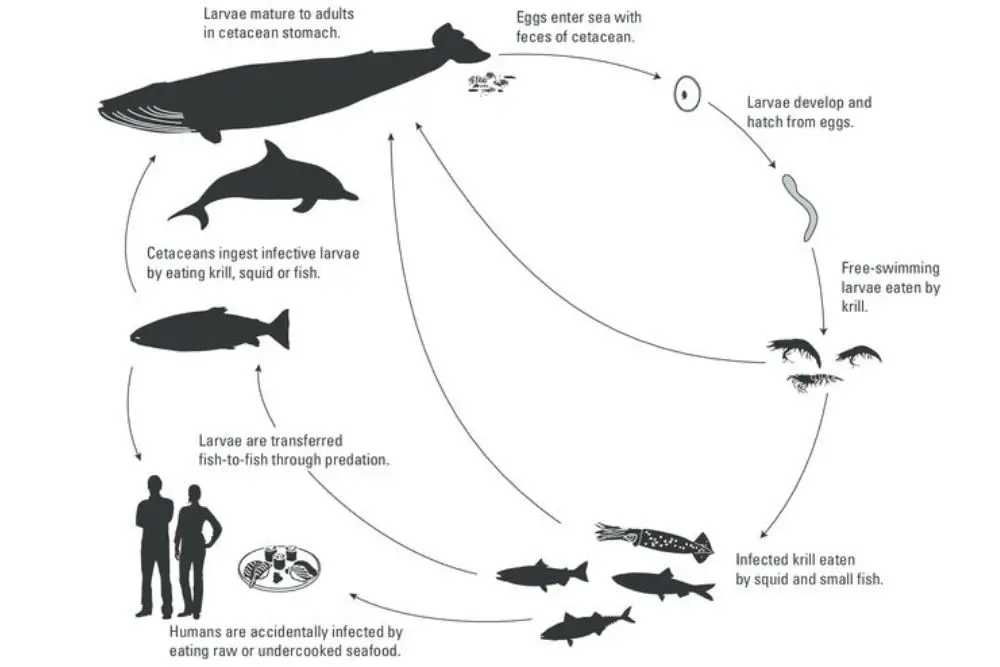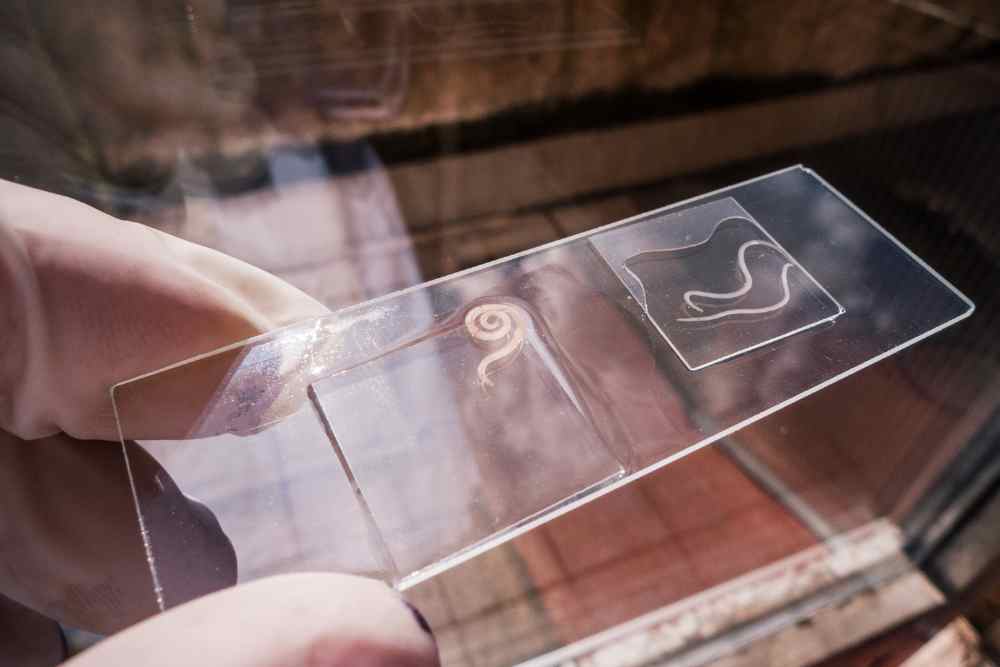Anisakiasis or anisakiosis is an human parasitic infection caused by a small parasite called Anisakis which can affect humans who consume raw or undercooked fish and seafood.
It is a preventable infection, so understanding the sources and symptoms of this condition is important for anyone who eats seafood.
This article will provide an overview of the causes, symptoms, diagnosis, prevention and treatment of anisakiasis.

Causes of Anisakiasis
The Anisakis grouped nematode parasites are the main causative agent for this zoonotic disease.
So what is Anisakis?
Anisakis species are marine nematode (roundworms) found in marine invertebrates (crustaceans and mollusks) and fish. It’s a a fish-borne parasite accidentally transfer to human body.
There major three species responsible for this disease in human body are:
- A. simplex complex – The three sibling species of the Anisakis simplex complex (A. simplex sensu stricto, A. simplex C and Anisakis pegreffii) are among the most widespread.
- A. pegreffii
- A. physeteris
The parasite Anisakis is most closely related to human parasite Ascaris.
Classification of Anisakis
- Kingdom: Animalia
- Phylum: Nematoda
- Class: Chromadorea
- Order: Rhabditida
- Family: Anisakidae
- Genus: Anisakis
Species of Anisakis
- A. berlandi
- A. brevispiculata
- A. nascettii
- A. oceanica
- A. paggiae
- A. pegreffii
- A. physeteris
- A. schupakovi
- A. similis
- A. simplex
- A. typica
- A. ziphidarum
Source: wikipedia.org
Geographical Distribution of Anisakis
The condition is most prevalent in areas where raw fish is a staple part of the diet, such as Japan, Scandinavian countries, the Netherlands, and Spain.
The parasites are also found in other locations that have a tradition of consuming raw or unsavory fish, including Norway, Canada, and the United States.
Some species of Anisakis worm can also be found in the coastal regions of different countries of Asia, Africa, and Australia.

Species Affected & Transmission
Anisakis worms can infect a variety of fish and squid species. Some of the species that are known to be infected with Anisakis worms and transmit the disease to human include:
- Cod (Gadus morhua)
- Herring (Clupea harengus)
- Mackerel (Scomber scombrus)
- Salmon (Salmo salar)
- Sardines (Sardina pilchardus)
- Anchovy (Engraulidae)
- Haddock (Melanogrammus aeglefinus)
- Plaice (Pleuronectes platessa)
- Sole (Solea spp.)
- Squid (Loligo vulgaris, Todarodes pacificus)
- Octopus (Octopus spp.)
- Eel (Anguilla anguilla)
Some species of fish are more likely to be infected by Anisakis than others, such as cod, herring, mackerel and salmon.
It’s important to note that the fish themselves aren’t the final host of the worm, but rather act as intermediate host.
The larvae are typically found in the viscera and muscles of the fish, and they can survive in fish that has been smoked, salted, or fermented.
Marine mammals such as seals, whales, and porpoises are considered the final host for the Anisakis, where the worm will mature and reproduce.
Life Cycle of Anisakis

The life cycle of Anisakis sp. involves several stages, including:
Adult: The adult female Anisakis worm lives in the stomach of marine mammals such as seals, whales, and porpoises. The adult worm releases eggs into the host’s stomach, which are then passed out in the host’s feces.
Embryonated egg: The eggs become embryonated in water and the first and second larval stages form in the egg.
Second larval stage (L2): The egg hatches and the second larval stage comes out in water and becomes a free swimmer.
Third larval stage (L3): The second larval stage is ingested by a crustacean (copepods), where it transforms into the third larval stage.
If the infected crustacean is eaten by a fish or other aquatic species, the third larval stage enters the body of the fish or squid and migrates into the muscle tissue.
As the larvae move up the food chain, they eventually reach their final host, the marine mammal.
Adult worm: When fish or squid containing third-stage (L3) larvae are ingested by marine mammals, the larvae molt twice and develop into adult worms.
Human infection: Humans can become infected with Anisakis sp. by eating raw or undercooked infected marine fish. After ingestion, the larvae penetrate the gastric and intestinal mucosa, causing symptoms of anisakiasis.

Anisakiasis Symptoms

Anisakis typically causes symptoms within a few days of infection, although in some cases it can take longer for symptoms to appear.
Common sign & symptoms are:
- Abdominal pain: This is often the first symptom and can be mild to severe. The pain is usually located in the upper part of the abdomen, but can also be felt in the lower part.
- Mild to acute nausea, vomiting and diarrhea
- Appetite loss
- Severe allergic reaction: Urticaria, angioedema and anaphylaxis
It’s worth noting that these symptoms can vary from person to person and not everyone will experience the same symptoms.
Anisakiasis Diagnosis

Changes in Host Behavior
The major diagnosis of affected humans is typically made based on the presence of symptoms, such as abdominal pain, nausea, vomiting, and diarrhea, along with a history of consuming raw or undercooked fish or squid.
Detection of Serum IgE Antibodies
Serological test such as enzyme-linked immunosorbent assay (ELISA) can be used to detect the presence of antibodies (IgE produce in body) against the allergenic proteins in the blood.
The antibody produce as a result of allergic host defense responses against Anisakis protein.
Gastroscopy and Colonoscopy
Endoscopic procedures such as gastroscopy and colonoscopy can be performed to visualize the larvae.
In this procedure, a thin, flexible tube with a light and camera on the end is inserted through the mouth or rectum, respectively, and can help detect the presence of worms in the stomach or intestines.
A definitive diagnosis can be made by identifying the worm during endoscopy or surgically and by biopsy.
Overall, a combination of symptoms, clinical presentation, imaging and serological test can be used to make a diagnosis of anisakiasis.
Prevention of Anisakiasis
There are several steps that can be taken to prevent anisakiasis in humans:
Cook Fish Thoroughly
Cooking fish to an internal temperature of at least 63°C (145°F) for at least 15 seconds will kill the Anisakis larvae and prevent infection.
Avoid Raw Fish & Seafood
Consuming raw or undercooked fish, especially species that are known to be infected with Anisakis worms, such as cod, herring, mackerel, and salmon, should be avoided.
Certain species of non fish aquatic animals such as squid, octopus, and eel, are particularly prone to infestation and are best avoided, if possible.
Purchase from Registered Distributor
It’s better to buy fish from certified distributors or from geographical zones where the fish is less likely to be infested.
Freezing
Some countries such as Japan have regulated freezing fish and squid for certain periods of time before consumption as a way of killing the larvae.
For example, freezing at -20°C (-4°F) for at least 24 hours or at -35°C (-31°F) for at least 15 hours will kill the Anisakis worms in fish and squid.
Peeling or Gutting
Peeling or gutting the fish before consumption can also help to reduce the risk of infection, as the worms are often found in the intestines and organs of the fish.
By following guidelines, individuals can reduce their risk of infection, but it is important to note that it’s not possible to completely eliminate the risk of infection through food as the contamination could happen in the fishing or packaging process.
Anisakiasis Treatment
Endoscopy or Surgery
Anisakiasis is typically treated with a procedure called endoscopy, during which a long, flexible tube with a small camera and a light on the end is inserted through the mouth and into the stomach.
The surgeon can then use special tools to remove the worm from the stomach wall.
However, in some cases if the worm was already in the intestinal tract or has already migrated to other parts of the body. The treatment may be more difficult and involves a surgery to remove them.
Anti-Inflammatory Drugs
Anti-inflammatory drugs and antibiotics may be used to reduce the risk of complications, but they are not effective at killing the worm itself.
Some researchers have suggested that certain drugs, such as albendazole or mebendazole, may have potential as treatments for anisakiasis.
These drugs are used to treat other parasitic infections, and they work by preventing the worm from absorbing glucose, which causes it to weaken and eventually die.
How Do You Avoid Sushi Parasites?
The best way to avoid sushi parasites is to make sure that the fish and seafood used to make sushi is properly handled and cooked before consumption.
Here are a few steps you can take to reduce your risk of infection:
-Purchase fish and seafood from reputable sources: Make sure the fish and seafood you purchase is from a trusted source and has been properly stored and handled.
-Ask for sushi-grade fish: Some species of fish have a higher risk of carrying parasites than others. Ask your sushi chef to use sushi-grade fish, which have been screened and certified to be safe to eat raw.
-Freeze the fish properly: Freezing fish at a temperature of -35°C for at least 7 days, or at -20°C for at least 15 hours will kill most parasites and their larvae. Be aware that not all parasites are killed at these temperatures.
-Cook the fish thoroughly: Cooking fish to an internal temperature of at least 63°C will kill any parasites that may be present.
Immunology of Anisakiasis
The human immune system responds to the infection by producing antibodies against the parasite, including IgE. These antibodies can help to protect against future infections by binding to and neutralizing the parasite.
In addition to antibody production, the immune system also mounts a cellular response to the infection.
Inflammatory cells, such as eosinophils and macrophages, are attracted to the site of infection, where they can phagocytose and kill the parasite.
The inflammatory response caused by the infection can also lead to the formation of granulomas, which are clusters of inflammatory cells that can encapsulate and contain the parasite.
Overall, the human immune system plays a crucial role in controlling and resolving infection. However, in some cases, the host immune response can be excessive and lead to tissue damage and the formation of fibrotic tissue.
FAQs
Does Anisakis go away on its own?
Once the worm is inside the human body, it will not go away on its own. If left untreated, the worm can cause inflammation and damage to the stomach or intestinal wall, leading to complications such as stomach ulcers or peritonitis.
How is anisakiasis transmitted?
The infection is typically transmitted when a person eats fish or squid that is infected with the Anisakis worm.
The life cycle of the Anisakis worm starts with eggs that are laid by adult worms in the ocean. These eggs hatch into larvae, which are then ingested by small crustaceans like krill. Fish and squid that feed on these crustaceans become infected with the larvae.
When humans consume raw or undercooked fish or squid that is infected with the Anisakis worm, the larvae can survive in the stomach and small intestine, where they attach themselves to the stomach or intestinal wall and begin to grow.
Once the larvae has attached itself, it cannot be easily dislodged by stomach acid or enzymes.
Is anisakiasis fatal?
It is generally considered to be a relatively mild infection, and most people who are infected with the Anisakis worm will recover fully with appropriate treatment.
However, in rare cases, the infection can cause severe complications and even death. Complications can include peritonitis, which is an inflammation of the lining of the abdomen, that in severe cases can lead to sepsis.
Sepsis is a life-threatening condition that occurs when the body’s response to an infection causes inflammation throughout the body. It can lead to organ failure and death if not treated promptly.
In addition, in some rare cases, an allergic reaction to the worm can happen, which may also lead to fatal anaphylaxis, which is a severe allergic reaction that can cause difficulty breathing, low blood pressure, and unconsciousness.
Can anisakiasis kill you?
It can also cause an allergic reaction in some people, which can be severe. Symptoms of an allergic reaction include hives, itching, and difficulty breathing. An allergic reaction can be treated with antihistamines and steroids.
Is Anisakis a tapeworm?
Anisakis is not a tapeworm. It is a nematode worm, which is a type of roundworm. Tapeworms are a different type of parasitic worm that belong to the cestode class of worms.
The worm can survive in the stomach and small intestine, where they attach themselves to the stomach or intestinal wall and begin to grow.
Tapeworms can grow up to several meters in length, and are usually treated with medication.
How long do Anisakis symptoms last?
The duration of symptoms of anisakiasis can vary depending on several factors, including the location of the worm, the severity of the infection, and how quickly the worm is removed.
Symptoms of anisakiasis typically appear within a few days of infection, but they can take longer to appear in some cases.
Once the worm is removed, the symptoms will typically improve within a day or two. However, some people may have lingering abdominal pain or other symptoms that can last for a week or more.
How long does sushi parasite last? (Anisakiasis incubation period)
The duration of a sushi parasite infection can depend on the type of parasite and the severity of the infection.
Some parasitic infections may be acute and cause symptoms within a few days of infection, while others may be chronic and have symptoms that persist longer for months or even years.
Anisakiasis, which is caused by the larvae of the Anisakis worm, is one of the most common parasitic infections associated with eating sushi.
Other parasites commonly found in sushi include Diphyllobothrium (a type of tapeworm) and Cyclospora cayetanensis (a single-celled parasite). Both of these parasites can cause chronic infections that can last for months. The duration of symptoms can vary, and can include abdominal pain, diarrhea, and weight loss.
What is Zoonotic disease? Is Anisakiasis a zoonotic disease.
A zoonotic disease is an illness that can be transmitted from animals to humans. These diseases can be caused by a variety of pathogens, including viruses, bacteria, parasites, and fungi.
Yes, Anisakiasis is a zoonotic disease, which means it can be transmitted from animals to humans. The disease is caused by the larvae of the nematode Anisakis simplex, which can infect a variety of marine mammals and fish, including salmon, cod, and mackerel.
References
- Nieuwenhuizen, N. E., & Lopata, A. L. (2013). Anisakis–a food-borne parasite that triggers allergic host defences. International journal for parasitology, 43(12-13), 1047-1057.
- Adroher-Auroux, F. J., & Benitez-Rodriguez, R. (2020). Anisakiasis and Anisakis: An underdiagnosed emerging disease and its main etiological agents. Research in veterinary science, 132, 535-545.
- Umehara, A., Kawakami, Y., Araki, J., & Uchida, A. (2007). Molecular identification of the etiological agent of the human anisakiasis in Japan. Parasitology International, 56(3), 211-215.
- Angeles-Hernandez, J. C., Gomez-de Anda, F. R., Reyes-Rodriguez, N. E., Vega-Sanchez, V., Garcia-Reyna, P. B., Campos-Montiel, R. G., & Zepeda-Velazquez, A. P. (2020). Genera and species of the Anisakidae family and their geographical distribution. Animals, 10(12), 2374.
- Paoletti, M., Mattiucci, S., Colantoni, A., Levsen, A., Gay, M., & Nascetti, G. (2018). Species-specific Real Time-PCR primers/probe systems to identify fish parasites of the genera Anisakis, Pseudoterranova and Hysterothylacium (Nematoda: Ascaridoidea). Fisheries Research, 202, 38-48.
- Nieuwenhuizen, N., Lopata, A. L., Jeebhay, M. F., De’Broski, R. H., Robins, T. G., & Brombacher, F. (2006). Exposure to the fish parasite Anisakis causes allergic airway hyperreactivity and dermatitis. Journal of Allergy and Clinical Immunology, 117(5), 1098-1105.
- Moneo, I., Caballero, M. L., Gomez, F., Ortega, E., & Alonso, M. J. (2000). Isolation and characterization of a major allergen from the fish parasite Anisakis simplex. Journal of Allergy and Clinical Immunology, 106(1), 177-182.
- Mattiucci, S., Cipriani, P., Levsen, A., Paoletti, M., & Nascetti, G. (2018). Molecular epidemiology of Anisakis and anisakiasis: an ecological and evolutionary road map. Advances in parasitology, 99, 93-263.
- Molina-Fernandez, D., Rubio-Calvo, D., Adroher, F. J., & Benítez, R. (2018). Molecular epidemiology of Anisakis spp. in blue whiting Micromesistius poutassou in eastern waters of Spain, western Mediterranean Sea. International journal of food microbiology, 282, 49-56.
- dos Santos, C. A. L., & Howgate, P. (2011). Fishborne zoonotic parasites and aquaculture: a review. Aquaculture, 318(3-4), 253-261.
- Shamsi, S., Briand, M. J., & Justine, J. L. (2017). Occurrence of Anisakis (Nematoda: Anisakidae) larvae in unusual hosts in Southern hemisphere. Parasitology International, 66(6), 837-840.
- Armentia, A., Santos, J., Serrano, Z., Martin, B., Martín, S., Barrio, J., & Palacios, R. (2017). Molecular diagnosis of allergy to Anisakis simplex and Gymnorhynchus gigas fish parasites. Allergologia et Immunopathologia, 45(5), 463-472.